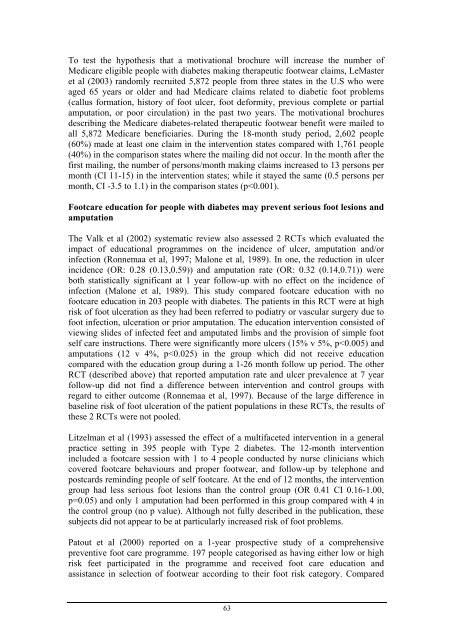Part 6: Detection and Prevention of Foot Problems in Type 2 Diabetes
Part 6: Detection and Prevention of Foot Problems in Type 2 Diabetes Part 6: Detection and Prevention of Foot Problems in Type 2 Diabetes
Mazzuca et al (1986) studies 532 people with diabetes (type not stated) in a primarycare setting. Subjects were randomised to an intervention group who receivedinstruction on footcare, and a control group. Follow up at between 11.8 and 14.3months showed no difference in level of knowledge. Of the original cohort 275 (52%)completed the follow up assessment.Other studies have also examined this question. One hundred people (mean age 65years) with diabetes and high risk feet attended a two-session education programmeconducted by a diabetes educator 3 months apart in this cohort study (Ward et al,1999). The programme included foot self examination, foot washing, proper footwear,and encouragement in enlisting proper physician foot care. Data on 34 people whoattended both sessions showed a significant improvement in knowledge score duringthe first visit (p
To test the hypothesis that a motivational brochure will increase the number ofMedicare eligible people with diabetes making therapeutic footwear claims, LeMasteret al (2003) randomly recruited 5,872 people from three states in the U.S who wereaged 65 years or older and had Medicare claims related to diabetic foot problems(callus formation, history of foot ulcer, foot deformity, previous complete or partialamputation, or poor circulation) in the past two years. The motivational brochuresdescribing the Medicare diabetes-related therapeutic footwear benefit were mailed toall 5,872 Medicare beneficiaries. During the 18-month study period, 2,602 people(60%) made at least one claim in the intervention states compared with 1,761 people(40%) in the comparison states where the mailing did not occur. In the month after thefirst mailing, the number of persons/month making claims increased to 13 persons permonth (CI 11-15) in the intervention states; while it stayed the same (0.5 persons permonth, CI -3.5 to 1.1) in the comparison states (p
- Page 12 and 13: Background - Peripheral Neuropathy
- Page 14 and 15: proportion of subjects with a durat
- Page 16 and 17: and an OR 1.1-7.8. This study also
- Page 18 and 19: Summary - Peripheral Neuropathy as
- Page 20 and 21: Section 2: Diabetes Foot ProblemsIs
- Page 22 and 23: predicting risk of amputation, 2.9
- Page 24 and 25: Summary - Peripheral Vascular Disea
- Page 26 and 27: Section 3: Diabetes Foot ProblemsIs
- Page 28 and 29: Evidence - Foot Deformity and Previ
- Page 30 and 31: people with both LJM and neuropathy
- Page 32 and 33: Summary - Foot Deformity and Previo
- Page 34 and 35: Section 4: Diabetes Foot ProblemsIs
- Page 36 and 37: Also in the Seattle study, 67 peopl
- Page 38 and 39: Summary - Ulcer as a Risk Factor fo
- Page 40 and 41: Section 5: Diabetes Foot ProblemsIs
- Page 42 and 43: The other frequently reported metho
- Page 44 and 45: side; and 82% having the same resul
- Page 46 and 47: Evidence Table: Section 5Detection
- Page 48 and 49: Background - Clinical Detection of
- Page 50 and 51: pulse was bilaterally absent in 1.8
- Page 52 and 53: Evidence Table: Section 6AuthorClin
- Page 54 and 55: Background - Frequency of Foot Exam
- Page 56 and 57: Summary - Frequency of Foot Examina
- Page 58 and 59: Section 8: Diabetes Foot ProblemsIs
- Page 60 and 61: Behaviour assessment scores, measur
- Page 64 and 65: with before the programme, after 1-
- Page 66 and 67: Evidence Table: Section 8AuthorEffe
- Page 68 and 69: Background - Glycaemic Control and
- Page 70 and 71: In a previous Japanese randomised s
- Page 72 and 73: Evidence Table: Section 9AuthorGlyc
- Page 74 and 75: Background - Footwear to Reduce Ulc
- Page 76 and 77: period. In addition people without
- Page 78 and 79: Comparisons of in-shoe foot pressur
- Page 80 and 81: The rate of plantar callus formatio
- Page 82 and 83: Evidence Table: Section 10AuthorFoo
- Page 84 and 85: Background - Foot Clinics and Multi
- Page 86 and 87: A prospective non randomised contro
- Page 88 and 89: Summary - Foot Clinics and Multi-di
- Page 90 and 91: Section 12: Diabetes Foot ProblemsI
- Page 92 and 93: and/or osteomyelitis; III - fore-fo
- Page 94 and 95: Summary - Economic consequences•
- Page 96 and 97: Section 13: Diabetes Foot ProblemsI
- Page 98 and 99: Some ethnic groups are associated w
- Page 100 and 101: Evidence Table: Section 13AuthorSoc
- Page 102 and 103: Calle-Pascual AL, Duran A, Diaz A,
- Page 104 and 105: Jannink MJ, van Dijk H, de Vries J,
- Page 106 and 107: Moss SE, Klein R, Klein BE. The 14-
- Page 108 and 109: Soulier SM, Godsey C, Asay ED, Perr
- Page 110 and 111: Diabetes Foot Problems: General Ref
To test the hypothesis that a motivational brochure will <strong>in</strong>crease the number <strong>of</strong>Medicare eligible people with diabetes mak<strong>in</strong>g therapeutic footwear claims, LeMasteret al (2003) r<strong>and</strong>omly recruited 5,872 people from three states <strong>in</strong> the U.S who wereaged 65 years or older <strong>and</strong> had Medicare claims related to diabetic foot problems(callus formation, history <strong>of</strong> foot ulcer, foot deformity, previous complete or partialamputation, or poor circulation) <strong>in</strong> the past two years. The motivational brochuresdescrib<strong>in</strong>g the Medicare diabetes-related therapeutic footwear benefit were mailed toall 5,872 Medicare beneficiaries. Dur<strong>in</strong>g the 18-month study period, 2,602 people(60%) made at least one claim <strong>in</strong> the <strong>in</strong>tervention states compared with 1,761 people(40%) <strong>in</strong> the comparison states where the mail<strong>in</strong>g did not occur. In the month after thefirst mail<strong>in</strong>g, the number <strong>of</strong> persons/month mak<strong>in</strong>g claims <strong>in</strong>creased to 13 persons permonth (CI 11-15) <strong>in</strong> the <strong>in</strong>tervention states; while it stayed the same (0.5 persons permonth, CI -3.5 to 1.1) <strong>in</strong> the comparison states (p



